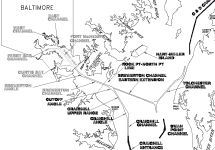



The Port of Baltimore has 45 miles of waterfront of which 25 miles are industrially developed. There are 94 covered and open overseas piers for the loading and discharging of 173 ships, providing 84 general cargo, 65 specialized cargo, and 24 public bulk cargo berths. The existing ground storage is equivalent to 53,700 railroad cars of cargo. There are 31 public general merchandize warehouses, with 4.9 million square feet of storage space and 4.7 million cubic feet of cost storage space. Eight ship-building, ship repair and ship dismantling yards are available for handling up to 90 vessels. The two grain elevators in the port have a capacity of about 8 million bushels.
The harbor is situated on the Patapsco River Basin on the west side of upper Chesapeake Bay about 172 miles north of the Virginia capes. Since 1980, over one-half billion dollars has been spent on maritime improvements in the Port of Baltimore. It is primarily a bulk-cargo port. The port has four large modern ore piers, three coal piers, two waterfront grain elevators with more than an 8,000,000-bushel total capacity and extensive facilities for handling such commodities as fertilizer and chemical products, break bulk, general, and containerized cargo.
The three coal terminals are capable of loading vessels drafting 47 feet. The four public terminals are equipped with the latest in cargo-handling equipment, a large auto terminal and numerous privately-owned facilities capable of handling a multitude of cargoes. Reported commerce for 1989 included 44,883,667 tons and 267,458 commercial passengers. The Port of Baltimore has two deep water routes to the sea. The northernmost route is through the Chesapeake and Delaware Canal to Delaware Bay. The canal, operated by the Corps of Engineers, provides a short, protected route to Baltimore from other leading North Atlantic ports. The main 50-foot shipping channel extends from the Atlantic Ocean at Cape Henry, north through the Chesapeake Bay to the Port of Baltimore. The "Baltimore Harbor Anchorages and Channels" feasibility study was initiated in June 1993 and was completed in April 1997. The study was funded by the Baltimore District Corps of Engineers and the Maryland Port Authority to determine whether there is federal interest in pursuing potential improvements to the anchorages and branch channels serving the Port of Baltimore. Many large, deep draft vessels are unable to anchor within the Port of Baltimore due to their extreme size and, therefore, are required to use anchorage areas 25 miles south of Baltimore at the Annapolis Anchorage Grounds. In addition, many of these larger vessels require additional time to maneuver in the narrow branch channels, thereby increasing operating costs to shippers. The goal of the study was to determine whether an economically justified project can be constructed to alleviate these problems and recommend further study in a feasibility report. Potential improvements investigated included constructing a larger and deeper anchorage area within the Port of Baltimore to accommodate larger vessels as well as widening some of the existing branch channels which serve the public terminals.In 1997 the US Army Corps of Engineers, Baltimore District, conducteda Feasibility Study and Environmental Impact on Baltimore Harbor Anchorages and Channels. The study recommended the widening and deepening of various channels, construction of a turning basin at the head of Fort McHenry Channel, assumption of maintenance responsibilities by the federal government for certain channels and the placement of 4.4 million cubic yards of dredged material at Hart-Miller Island.
